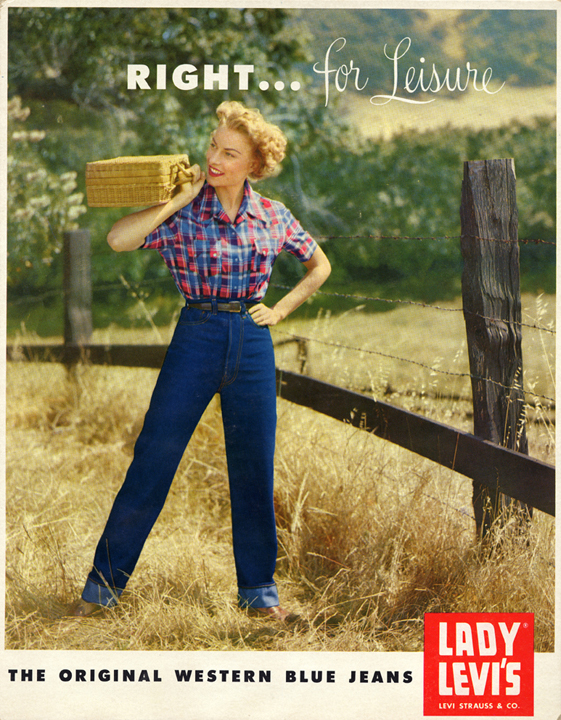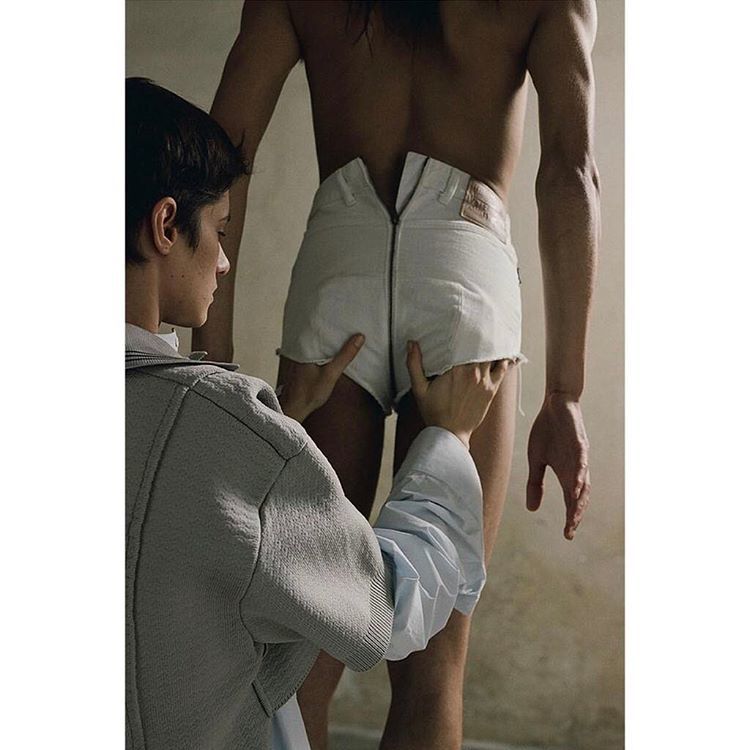This year, the fashion world has been blessed with a fair share of denim controversies. Each week, a new style appears to challenge our sense of morality and good taste. From clear panel jeans, Vetements butt zippers, and over-priced mud encrusted details, whenever denim ventures into any territory beyond a fashion staple, things get complicated. Hey, we get it. Jeans are always a safe bet, a little piece of durable style sanity during a turbulent period in history. Mess with them, and people get uncomfortable.
In his book Jeans: A Cultural History of an American Icon, James Sullivan reflects that the garment has come to embody “two centuries’ worth of the myths and ideals of American culture.” But their influence isn’t confined to the continent, during the last century they’ve become entwined with ideas of youth, rebellion, class, and sex — all matches for public dialog and outrage.
But despite our recent outrage over clickbait-worthy designs, the history of jeans shows they’re no strangers to controversy. If anything, the more scandalous and headline catching the design, the more true it is to the garment’s heritage.
At the start of their life, jeans were workwear worn by cowboys and farm hands in America’s untamed West. As the 20th century came crashing into view, their wearers were increasingly painted by American mythology as romantic and enigmatic outsiders. On the East Coast, the men who wore jeans were viewed as the distant ideal of American masculinity.
Jeans began to creep into the mainstream when teenagers reinvented them. Largely spurred by Hollywood’s brooding presentation of teen angst, their style icons were Marlon Brando in 1953’s The Wild One and James Dean in Rebel Without a Cause two years later. Speaking to the BBC, Lynn Downey, archivist and historian at Levi Strauss & Co, reflected that from then on “Hollywood costume designers put all the bad boys in denim.”

As teenagers continued to embrace them across the 50s, jeans were eventually banned from many high schools — which only made them more desirable. Reflecting on this time, Mary Ellen Snodgrass, author of World Clothing and Fashion: An Encyclopedia of History, Culture, and Social Influence told Bustle, “The media and fundamentalist churches depicted sloppily dressed teens as gang members, social dropouts, and potential troublemakers.” Continuing, she explained: “Schools and colleges banned denim attire because of the association of jeans with social alienation, beatnik verse, and juvenile delinquency — the antithesis of the conservative ‘man in the gray flannel suit.'”
Beyond school halls, jeans were also seen as the the uniform of young men returning from WW2-Europe who resisted middle-class family-man dreams. These ex-GIs weren’t interested in succumbing to suburbia. As Downey notes, “They freaked out the establishment in the United States because they were not conforming and they were wearing jeans.”
But it wasn’t only boys who were making waves in denim. When Levis created Lady Levi in 1934, Vogue praised the style by calling it “true Western chic.” But women had been wearing jeans since the 1870s, when female farm workers recognized their practicality. By the 1900s, they were appearing on cowgirls at rodeos. While that sounds like a sensible outfit choice, wearing pants as a woman was a radical move 117 years ago.

Up until the 50s, women’s jeans were adapted from men’s cuts. But as the style began to catch on among young women, more flattering designs were developed for the female shape. Jeans were easier to buy and fit now, but they were still far from a wardrobe staple. While we may look back on shots of Audrey Hepburn or Marilyn Monroe in a ladylike pair of cropped skinny jeans as a point of cool elegance, the general public still pointed to the pants as evidence of the decline of female morals. Looks that today are held up as chic were often considered slovenly back then.
By the late 70s, jeans were totally normalized and worn by kids and grandparents alike. But during this period, they would enter their next period of social reinvention as designers and advertisers began highlighting their sex appeal. Brands like Guess, Calvin Klein, and Fiorucci would spend the following decades repositioning jeans in the broader culture, once again bringing down the age bracket on denim and returning an element of its rebellious appeal. Speaking to i-D, Elio Fiorucci once declared, “Jeans changed the world.” Continuing, he explained the moment he knew jeans were going to be part of the Fiorucci identity — and hence the fashion world at large: “One day, I was driving in my car with my wife in Ibiza and between the scattered cottages we saw some beautiful topless girls wearing their jeans while diving into the water. Their jeans completely stuck to them, resulting in such beautiful legs and bums. They were not just women, but indigo blue statues.”
The moment spurred the idea that women “should not wear jeans made for men.” This, coupled with the rise of elastic denim blends that clung to the body, began an indigo-colored sexual revolution. In the 80s, Calvin Klein would once again remind the world of how controversial jeans could be when one of their advertisements had a 15-year-old Brooke Shields famously ask us, “You want to know what comes between me and my Calvins? Nothing.” The ad was banned in many countries. 34 years later, Alexander Wang literally had to present Anna Ewers naked with her barely visible jeans around her ankles to make news.
Moving into the last part of the century, jeans weren’t totally out of the news. Now the focus was shifted to style, or, rather, how low and tight could you go? The trend of wearing jeans low on the hips began in the 1960s, but reached its peak as a talking point in the 90s when skaters and hip hop artists embraced the look. Popular among boys and rappers, the resulting wave of parental backlash mirrored the first blush of 1950s concern. On women, the look arguably peaked with the introduction of Alexander McQueen’s now iconic “bumster” jeans in his 93 Taxi Driver collection. McQueen insisted the design wasn’t about showing off the ass, but, rather, elongating the lower part of a woman’s back. He later explained to The Guardian “that part of the body — not so much the buttocks, but the bottom of the spine — that’s the most erotic part of anyone’s body, man or woman.”
Despite being meant as a love letter to the female body, not everyone was a fan. By 2004, Louisiana State Legislator Derrick Shepherd was attempting to outlaw the look, calling it disrespectful and obscene. If his proposed law had passed, anyone displaying their underwear over their jeans would receive a $500 fine. The bill was rejected by the Louisiana House of Representatives; but the low, tight style was subject to medical, as well as moral, concern.
A year earlier, the Canadian Medical Association Journal ran an article that said the style could put pressure on a sensory nerve in the thigh, which could result in pain and paresthesia. Over a decade later in 2015, a 35-year-old Australian woman was actually admitted to hospital and cut out of her skinny jeans when her calves began to balloon and her feet went numb. She was diagnosed with a condition called compartment syndrome that was exacerbated by her jeans. While doctors stressed the case was extremely unusual and that skinny jeans were safe, it didn’t stop the tidal wave of op-eds from once again condemning the style.
After reviewing more than a century of fraught, controversial, sexy, and dangerous denim history, one thing is clear: there is no right or wrong way to wear jeans. They’re as much a working class staple as a high fashion product, a sign of casual elegance or social revolt. If anything, the only thing more era-defining than jeans themselves is the outrage they evoke.
Credits
Text Wendy Syfret
